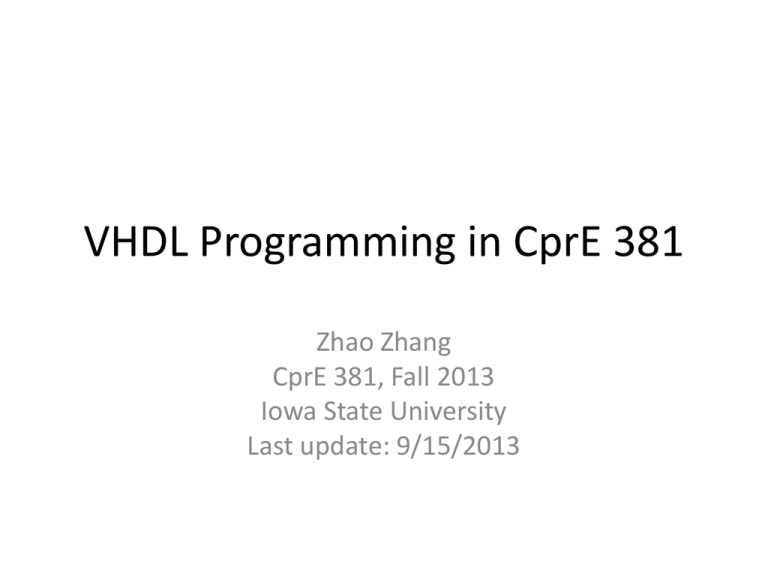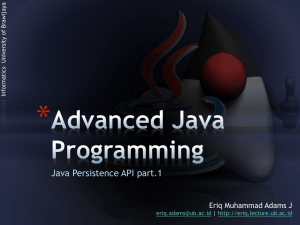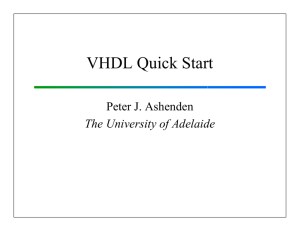VHDL Notes for CprE 381
advertisement

VHDL Programming in CprE 381 Zhao Zhang CprE 381, Fall 2013 Iowa State University Last update: 9/15/2013 VHDL Notes for Week 4 • Generic Constant • Entity and component • Test bench Generic Constant • Generic constant is used to parameterize an entity entity one_complement is generic(constant N : integer := 16); port(i_A : in std_logic_vector(N-1 downto 0); o_F : out std_logic_vector(N-1 downto 0)); end one_complement; • Can be added to entity • Takes a default value Generic Constant architecture behavior of tb_one_complement is component one_complement generic(constant N: integer := 32); port(i_A : in std_logic_vector(N-1 downto 0); o_F : out std_logic_vector(N-1 downto 0)); end component; … begin … • The default value can be changed in a component statement Generic Constant C1: entity work.one_complment(behavior) generic map (N => 32) port map (i_A => s_A, o_F => s_F); C1: one_complement generic map (N => 32) port map (i_A => s_A, o_F => s_F); • The generic constant value can also be decided in a component instantiation statement Entity and Component • Be default a component is associated with an entity of the same name • Component can be configured in configuration specification to associate with an entity and an architecture for C1 : one_complement use entity work.one_complment(behavior) for all : one_complement use entity work.one_complment(behavior) Generate Statement • A for…generate statement may used in an architecture to instantiate an array of component instances G1: for i in 0 to N-1 generate inv_array: inv port map(i_A => i_A(i), o_F => o_F(i)); end generate; Generic Example architecture structure of one_complement is component inv port(i_A : in std_logic; o_F : out std_logic); end component; begin G1: for i in 0 to N-1 generate inv_i: inv port map(i_A => i_A(i), o_F => o_F(i)); end generate; end structure; Test Bench • Test bench provides stimulus to the simulation • Its entity statement is usually empty entity tb_one_complement is end tb_one_complement; Test Bench architecture behavior of tb_one_complement is … -- components, signals, component instances -- The test sequence process begin s_A <= X"00000001"; wait for 100 ns; s_A <= X"00001000"; wait for 100 ns; end process; -- it repeats end behavior; VHDL Notes for Week 5 • Mixing VHDL styles: Structure, data flow, behavior • Model a truth table • Model a register file VHDL Notes in 381 • I will discuss VHDL programming techniques just for the need of CprE 381 – The notes are customized for the labs – I’m not a VHDL expert (used to program in Verilog) • Take the notes as exposure to new techniques – The notes will only cover the essential of each technique – Search Internet or get a good VHDL book, for the complete description and details – The “VHDL tutorial” is a good starting point but may not be sufficient Structure, Dataflow and Behavior • Those are different ways to model a hardware component entity my_circuit is port(i1, i2, i3, i4 : in bit; o : out bit); end my_circuit; Structure, Dataflow and Behavior architecture mixed of signal wire1, wire2 begin nand_gate1 : entity port map (i1, i2, my_circuit is : bit; work.nand2(dataflow) wire1); nand_gata2 : block begin wire2 <= i1 nand i2; end block; nand_data3 : process (wire1, wire2) begin if (wire1 = ‘1’) and (wire2 = ‘1’) then o <= ‘0’; else o <= ‘1’; end if; end process; end Structure, Data Flow and Behavior • The previous example mixes three modeling styles: structure, data flow, and behavior • It uses three VHDL programming constructs (complex statements), each for a NAND gate – Component/entity instantiation – Concurrent signal assignment – Process statement • The logic circuits can be the same – Different modeling styles may or may not lead to the same circuit Model Truth Table Use case statement (behavior) architecture behavior of reg_decoder is begin -- input : 5-bit addr; output: 32-bit sel D : process (addr) begin case (addr) is when b”00000” => sel <= x”00000001”; when b”00001” => sel <= x”00000002”; … -- more cases when b”11111” => sel <= x”80000000”; end case; end process; end behavior; Model Truth Table Use selected signal statement (data flow) architecture dataflow of reg_decoder is begin -- input : 5-bit addr; output: 32-bit sel with addr select sel <= x”00000001” when b”00000”, x”00000002” when b”00001”, … -- more cases x”80000000” when bb”11111”; end dataflow; Model Regfile • A simplest way to mode register file is to use two process statements, with an array of 32bit internal signals – Not acceptable if you do it for Lab 3 assignment Model Regfile architecture behavior of regfile is signal reg_array : m32_regval_array; begin REG_READ : process (clk, src1, src2) variable r1, r2 : integer; begin r1 := to_integer(unsigned(src1)); r2 := to_integer(unsigned(src2)); rdata1 <= reg_array(r1); rdata2 <= reg_array(r2); end process; Continue… Model Regfile Continue… REG_WRITE : process (clk) variable r : integer; begin if (rising_edge(clk)) then if (WE = '1') then r := to_integer(unsigned(dst)); reg_array(r) <= wdata; end if; end process; end behavior; Lab 4 This Week • Part 1: Sign and Zero extension – You will need both in Mini-Projects B and C • What extension is needed in J instruction • What extension is needed in BNE instruction? • Part 2: Test a given memory implementation – It is like using an IP from other designers – Write your test carefully, make sure it really works Multiple Testing Processes • In a test bench, we may use multiple process statements • Example: Use two processes in REGFILE test bench – One process for generating clock signal – Another for providing control and data signals Multiple Testing Processes entity tb_reg32 is -- This is a single reg -- Half clock Cycle Time generic (HCT : time := 50 ns); end tb_reg32; architecture behavior of tb_reg32 is -- Clock Cycle Time constant CCT : time := 2 * HCT; -- Component and signal declarations … Multiple Testing Processes begin REG_A: reg32 port map (clk, rst, WE, D, Q); P_CLK : process begin clk <= '0'; wait for HCT; clk <= '1'; wait for HCT; end process; -- Clock generation -- Wait for half clock cycle -- Wait for half clock cycle Multiple Testing Processes P_DATA : process begin -- Reset the register rst <= '1'; wait for CCT; rst <= '0'; -- Write hex 0x12345678 WE <= '1'; D <= X"12345678"; wait for CCT; Multiple Testing Processes -- Test with WE = ‘0’ WE <= '0'; D <= X"00001010"; wait for CCT; -- More stimulus … end process; end behavior; Assert Statements assert condition report message severity level; • If the condition is false, report a message, and potentially stop the simulation • Can be useful in test bench for automatic testing – No need to read the waveform all the time – Help you quickly identify errors • Can also be used to self-check a logic circuit Assert Statement Example: Use report and assert statements inside a testing process -- Test register write report “Test on input 0x12345678”; WE <= '1'; D <= X"12345678"; wait for CCT; assert(Q = X"12345678") report ”Fail on input 0x12345678”; Assert Statement • Use severity level to tell the simulator whether to stop. assert(Q = X"12345678") report "Test input 0x12345678” severity ERROR; • Four severity levels and ModelSim behavior note: Just print the message warning: Print “warning” message error: Print “error” message (default) failure: Print “failure” message, break/pause the simulation Report Statement • You can also use report statements like printf – Note: You may need functions to convert std_logic_vector to integer, e.g. hex() – You may search the Internet or contact Dr. Zhang for the code TEST : process begin … report “rdata1 = “ & hex(rdata1) “rdata2 = “ & hex(rdata2); … end process; Debugging Single-Cycle Processor General debugging skills • Pause the simulation and inspect signals • Inspect register and memory contents • Be selective with waveform signals: There are too many signals! • Pause simulation and inspect signals at the right time, avoiding the rising clock edges Debugging Single-Cycle Processor Check the outcome of an instruction to see if it runs correctly – Check PC for all instructions – Check dest register for R-Type and load – Check memory word for store – Test taken and not-taken cases for branch Debugging Single-Cycle Processor Suggest strategy 1: Trace instruction execution in forward direction. Check: – – – – – – – – PC and instruction memory output rs, rt, shamt, funct, immediate All control signals Register read data ALU inputs and outputs Data memory address, data input, data output Register write data And other signals Debugging Single-Cycle Processor Suggest strategy 2: Trace instruction execution in backward direction. The tracing can be more focused Debugging Single-Cycle Processor A case of debugging: For code lw $t0, 0($zero) lw $t1, 4($zero) The first instruction runs correctly, the second doesn’t. Check on the second instruction: • Memory address: It is 0x00000000, not 0x00000004! • ALU result (address): it is indeed 0x00000000 (wrong) • ALU inputs – rdata1 = 0x00000000: OK – alu_input2 = 0x00000004: OK – ALU_code = "0000”: Wrong! That's AND operation Debugging Single-Cycle Processor Continue to check: • ALUop = "00”: OK Something is wrong with ALU control, continue: • Check inside of alu_ctrl.vhd: – I used ‘X’ in programming the truth table – Thought ‘X’ is “don't care”. No, that's Verilog! – In VHDL std_logic, ‘X’ is “unknown”, and "-" is “don't care”! • Then learned that VHDL 2002 doesn't support matching '0' or '1' with X in case statement – VHDL 2008 does support this feature – ModelSim (PE 10.2c) supports VHDL 2002 by default • Change a programming technique and then it works











